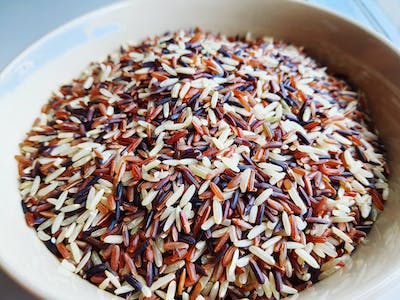What is Jasmine Rice?
A fragrant long-grain rice variant is called jasmine rice (also known as aromatic rice). Its aroma, which is evocative of both popcorn and pandan (Pandanus amaryllifolius), is produced naturally by rice plants, whose main aroma ingredient is 2-acetyl-1-pyrroline. Many Southeast Asians and experts favor each years freshly produced “new crop” of jasmine rice each due to a quick loss of fragrant strength.
When cooked, it has a moist, soft texture and a somewhat sweet taste. When cooked, the grains adhere to one another and become slightly sticky, but since it contains less amylopectin than glutinous rice (Oryza sativa var. glutinosa), it is less sticky. Compared to American long-grain rice, it is nearly three times stickier.
Where is Jasmine Rice grown?
Thailand, Cambodia, Laos, and southern Vietnam are the main countries where jasmine rice is farmed.
The tall stalks of jasmine rice are chopped and threshed during harvest. The rice can then be milled to remove the germ and part or all the bran to generate white rice, dehulled to produce brown rice, or left in its hulled condition to produce paddy rice.
Different types of Jasmine Rice
Many of the properties of Thai jasmine rice and Cambodian rice are similar, and both varieties are mostly grown in nearby regions on opposing sides of the northeastern Thai-Cambodian border. Jasmine rice from Cambodia is grown there and is produced as white (milled and polished) and brown rice.
Thai jasmine rice is thinly shaped and comes from Thailand. Thai jasmine rice comes in two varieties: white and brown. Thai jasmine rice makes up the great bulk of the jasmine rice sold outside of North America and Europe, with a tiny minority coming from Vietnam. Only Surin, Buriram, and Sisaket Provinces are known to be able to produce high-quality hom mali in Thailand.
White Jasmine Rice
Long grain, fragrant white jasmine rice is a kind of rice that is frequently used in Southeast Asian cooking. When cooked, it has a delicate, somewhat sweet aroma and a light, fluffy texture. It frequently goes with soups, curries, and stir-fried foods.
Brown Jasmine Rice
The bran layer and germ are still present in the whole-grain rice type known as brown jasmine rice. It has a chewy texture and a nutty, earthy taste. Brown jasmine rice has more fiber, vitamins, and minerals than white jasmine rice. It is frequently used in salads, bowls, and as a side dish and is a healthier option to white rice.
Jasmine Rice Uses
The best way to utilize jasmine rice depends on the kind you choose and what you are using it for, such as a side dish, soup, or stir-fry. To soften the bran, brown jasmine rice must be presoaked in warm water for a longer amount of time.
Contrarily, to preserve more of its unique color, black jasmine is best steamed or, if boiling, washed rather than soaked. The brown and black varieties, which have more bulk and less delicacy than the white kind, need more cooking time and go better with richer, earthier meals.
Jasmine Rice Recipes
Whatever you cook, whether it be a stir-fry, a side dish, or a soup, will benefit from the unique properties of jasmine rice. Just remember to rinse or soak it first and use a little less water while cooking so the rice is slightly undercooked if it will be used in a stir-fry or soup.
- Coconut-Infused Jasmine Rice
- Stir-Fried Jasmine Rice with Kale
- Thai Curry Chicken with Jasmine Rice
Health Benefits
Since rice is a common diet worldwide. Several health advantages of jasmine rice include:
Improves Immune System
Phytonutrient-rich jasmine rice comes in a variety of vibrant colors, including red, purple, and blue. Phytonutrients strengthen your immune system and general health by defending the cells in your body.
Promotes Healthy Pregnancy
Contains a lot of folic acids, like jasmine rice. When consumed before conception and during the first trimester, folic acid has been related to encouraging healthy pregnancies. Particularly, consistent folic acid consumption has been connected to lower rates of neural tube abnormalities and birth malformations. Because of this, eating jasmine rice is a wise choice both before and throughout pregnancy.
Supports Digestive Health
Compared to white jasmine rice, brown jasmine rice has more fiber. Because brown rice is less processed, fiber and minerals are still present. Normal bowel motions and digestive health are maintained by dietary fiber.
Potential Risks of Jasmine Rice
Despite being a common dish in many cultures, jasmine rice consumption has certain dangers. The following are some risks connected to this rice:
Blood Sugar Spikes
Jasmine rice has a rather high glycemic index, like all other types of rice. Even the brown kind of jasmine rice can raise blood sugar levels, which can be problematic for those with Type II diabetes.
Arsenic Levels
A poisonous heavy element called arsenic may be found in water, rock, and soil. Since rice is farmed in fields that are constantly submerged in water, arsenic accumulates faster than it does in other grains. Children may be particularly at risk from this. Make careful to properly wash the rice before cooking it to reduce the amount of arsenic in it.

